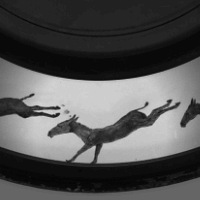Zoopraxiscope


The zoopraxiscope is an early device for displaying motion pictures. Created by photographic pioneer Eadweard Muybridge in 1879, it may be considered the first movie projector. The zoopraxiscope projected images from rotating glass disks in rapid succession to give the impression of motion. The stop-motion images were initially painted onto the glass, as silhouettes. A second series of discs, made in 1892–1894, used outline drawings printed onto the discs photographically, then colored by hand. Some of the animated images are highly complex, featuring multiple combinations of sequences of animal and human movement.
The device appears to have been one of the primary inspirations for Thomas Edison and William Kennedy Dickson's Kinetoscope, the first commercial film exhibition system. Images from all of the known seventy-one surviving zoopraxiscope discs have been reproduced in the book Eadweard Muybridge: The Kingston Museum Bequest (The Projection Box, 2004).
See also
External links
- Zoopraxiscope - Royal Borough of Kingston. Information about the Eadweard Muybridge Collection.
- Candy Spinner mobile application featuring zoopraxiscope images: Android, Apple